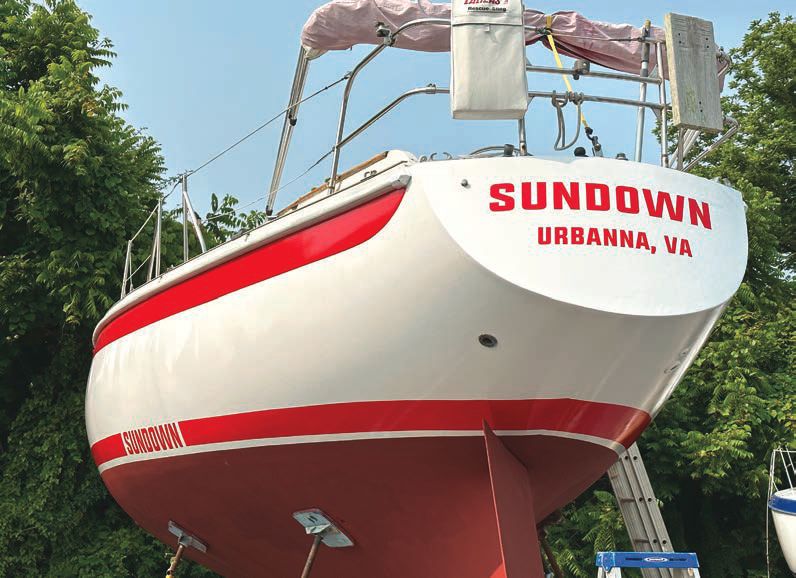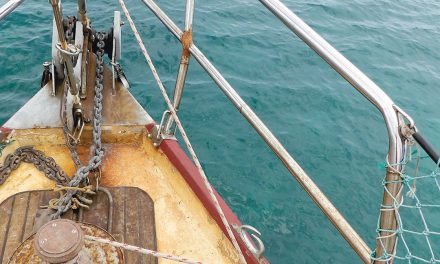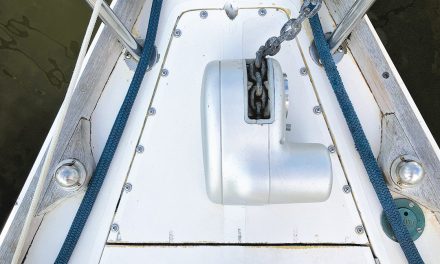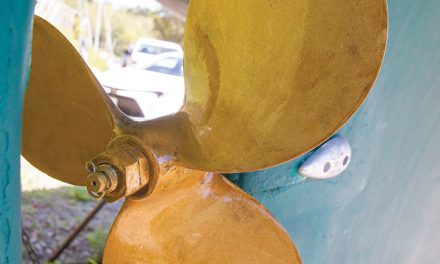The late Gordon Lightfoot’s ’70s-era Ericson gets a proper rig and hull refit
Issue 153: Nov/Dec 2023
The calls, emails, and texts started coming in to my wife, Lisa, and me on the evening of May 1. “I was so sorry to hear,” “I hope you’re OK,” and, “It must be sad for you.”
It was as though we had lost a family member. But the messages were condolences for someone who, although we had known about him for many years, we had only met once for about 20 minutes. The great Canadian singer-songwriter Gordon Lightfoot, known for If You Could Read My Mind, The Wreck of the Edmund Fitzgerald, Carefree Highway, and his biggest hit, Sundown, had passed away at the age of 84. Lightfoot was also the original owner of our 1976 Ericson 39B, Sundown, and was an early influence on my own musical career, hence the condolences on his passing.
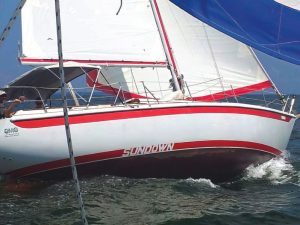
Sundown sails hard over in 2012, showing the original boot stripe graphic.
Sundown came into our lives in the aftermath of Hurricane Isabel in 2003. We had hurried down to our marina on the Potomac River to check on our Bristol 28, which survived the storm unscathed, unlike many boats around her. We ran into Simon, then the owner of Sundown, and over dinner, he let us know that he was planning to sell the boat. We weren’t looking for another boat at the time, but we decided then and there that Sundown would be our retirement boat — so we bought her 20 years before we planned to retire.
A couple of years after buying Sundown, my band partner John and his wife, Marty, took Lisa and me to see Gordon Lightfoot in concert at Wolf Trap in Northern Virginia. Our wives used a picture of the boat to talk our way backstage after the show, and Lightfoot came out of the dressing room area saying, “I want to see the people with the boat!” We talked about music and sailing, and about changes to Sundown since he had owned her. A longtime sailor and racing enthusiast on the Great Lakes, Lightfoot described how he’d had a custom wooden sloop built in Ontario and so had eventually sold Sundown. He was energetic and engaging, even after a several-hour show, and we thoroughly enjoyed the encounter.
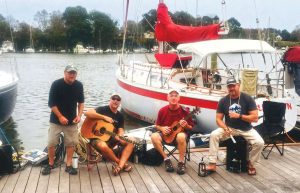
The author (with guitar) and bandmates
perform on the dock in front of Sundown
before the restoration.
We had been able to afford the boat because she had a host of issues that needed attention. Over the next several years, we repowered her with a factory-rebuilt Perkins 4108, cleaned up wiring and plumbing issues, and rebuilt the mast step and steering assembly, all while sailing her extensively up and down the Chesapeake Bay. What we were not able to do in that time, however, was give any serious attention to the aesthetic issues — in particular, her fading, crazing hull paint and peeling graphics, which had been designed by Lightfoot. That would have to wait until retirement.
The other big issue we faced was the fact that Lightfoot had the 57-foot mast filled with urethane foam to deaden the sound of slapping halyards (see more of the story on that at www.lightfoot.ca/ goldgoos.htm). This made it impossible to rewire the mast and had trapped moisture inside the stick. We had monitored some corrosion spots for years, but the mast needed a full inspection, rewiring, and repainting of the original white with red stripe design. When I eventually retired this past year, I made plans to haul the boat and pull the mast over the winter, and got started on a project that threatened to overwhelm me at times.
The mast was the first thing on my agenda when the boat was hauled out in November 2022. We laid her up on sawhorses and I started to chip away at the foam inside with a hand scraper on an extended paint pole. The foam was friable and relatively easy to break up in the center, but the edges had melted and hardened into a sharpedged wall against the aluminum interior of the mast. I was able to break this up a bit at a time, but caught a lot of long, ragged splinters — even through work gloves — in the process.
Eventually, I was able to fully clear the top 10 feet of the mast, which was where the corrosion was clustered. I managed to get an inspection camera down the mast and saw that other than a couple of pinhole spots, there was no additional visible corrosion inside. The exterior corrosion was more from paint bubbles than structural issues. To my great relief, the mast was still solid.
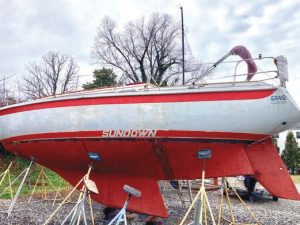
Sundown’s hull before the restoration had lots of wear and tear.

Removing the old paint and graphics was a long, slow process.
The next steps for reaming out the mast got more difficult, as the angle of the scraping tool made it impossible to get all of the foam as I went farther. I tried a couple of other tools but was having little luck progressing beyond the initial 10 feet. At that point, our marina owner offered the use of an industrial plumbing snake. With 100 feet of snake and a variety of cutting heads, I was able to work through more of the foam, getting around 20 feet in from each end, but the snake would twist and bog down at that point. My goal of working all the way through the mast was beginning to look like mission impossible.
After considering various options, I decided to continue digging through the mast using PVC pipe. I joined 60 feet of 1-1/2-inch PVC pipe and cut a slant on one end as a digging tool. With the help of my sailing friend Mark, I was eventually able to punch all the way through around the end of January. I ran fish tape down the newly excavated tunnel so we could pull new VHF cable and wiring through the length of the mast, and we celebrated the first success of the winter’s work with a well-deserved beer.
We next taped, sanded, primed, and rolled and tipped the mast with Pettit urethane paint. Keeping the original red stripe on the white mast presented some serious taping challenges, but after three coats of each color, I was happy to see a gleaming red and white mast emerge. I also painted the spreaders and ran the new wiring for the VHF, anchor light, steaming light, and deck lights.
In addition to repainting, the rig on Sundown was also way overdue for replacement. Our rigger, Keith, who had installed our roller furler a few years earlier, got the new rig to me and I installed it, set the spreaders, put on new spreader boots, and prepared everything for stepping. The mast was ready to go.
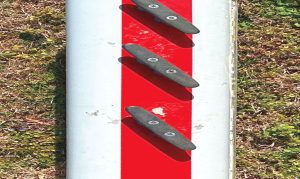
The mast and boom showed signs of corrosion on the outside, leading to fears of internal corrosion as well.
In February, I began to turn my attention to the tired hull. The first step was to remove the old scraped and cracked paint and prep for new painting. I held my breath as I put the random orbital sander to the hull for the first time, and was rewarded with the emergence of a smooth, clean undercoat, one square inch at a time. I spent the next two weeks sanding for hours upon hours, again with help from Mark, who eventually burned his own sander out on the task. The undercoat was in much better shape than I had anticipated, and its many dings and scratches disappeared as we sanded. Only a couple of gouges had reached the gelcoat. After those were faired, the hull was clean and ready for painting by the end of March.
Before the hull could be painted, however, I needed to repaint the trademark Ericson gunwale stripe. Taping was critical in all of the painting steps, and each session meant at least an hour of taping around the hull before painting. I used the same red Pettit urethane for the stripe that I had used for the mast to ensure a good match of color and appearance. After three coats on the gunwale stripe, I was ready to begin taping for the hull paint.
I had envisioned a roll-and-tip paint for the hull, with Pettit urethane or Awlgrip on my list of possible options. But Jimmy at the boatyard recommended Alexseal for hand painting. With the proper additives and careful prep, the paint goes on with a 4-inch foam roller and then spreads out without tipping. Friends expressed concern that it would take forever to paint a 39-foot boat with a 4-inch roller, but once the taping was complete, I could get around the entire hull, without rushing, in about 45 minutes. I had multiple weather delays, primarily from excessively windy spring days and lots of pollen in the air, but we eventually hit a run of days that were still, dry, and warm enough to paint.
The Alexseal was very easy to work with, as long as we followed the mixing instructions. Jimmy suggested a minimum of three coats of primer before applying the final hull paint. My goal for the first two coats of primer was to be able to apply the second coat within three hours so I wouldn’t need to sand between coats, but the wind and weather kicked up again. The primer was easy to sand, however, and I was able to get the boat hand sanded and wiped within about 40 minutes.
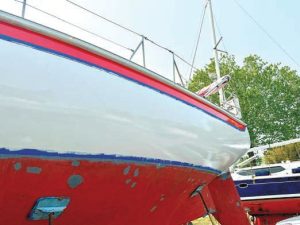
Taping was one of the most time-consuming tasks of the entire project.
Once the primer had fully cured, which took about two days in the mid70s with low humidity, I was ready to start on the hull paint. Just as with the primer, two coats could be applied in a threehour window without the need for sanding. I got the first two coats on in a day and gave them a couple of days to cure before sanding and applying the third coat. A couple of days later, I sanded and taped again, then applied the final two coats in an afternoon. After the last coat, I stepped back and realized that I had met my goal of bringing this tired old boat back to life … so far.
Another major issue in restoring the boat was remaining true to the original graphics designed by Lightfoot, which featured the boat name cut out of the red boot stripe. We ran into some problems because of the way the boot stripe curved under the stern. Few of the local graphics companies felt comfortable trying to replicate that curve and the cutout letters, and those that did quoted me prices that were way out of my budget. After a lot of thought, I decided to paint the boot stripe myself and have solid lettering placed in a gap that I would leave amidships.
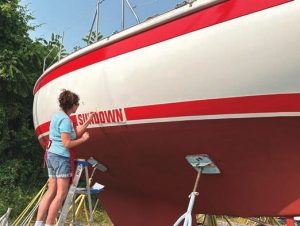
Roxy applies the name in the gap left on the boot stripe.
Painting the boot stripe was in many ways the most intense part of the painting effort. My taping had to be perfect, as did the spacing I would leave for the lettering that would be applied by Kilmarnock Lettering Company. One challenge was that the boot stripe flared from 5 ½ inches for most of the hull length to 11 inches wide where it curved under the stern. I had to guesstimate where and how much that flare expanded as the stripe progressed toward the stern and tape accordingly. I started on the port side, and as you can imagine, the process began with a lot of trial and error.
When I was satisfied with the outline of the stripe, I then had to measure every inch from where the stripe began to flare to where it reached the middle under the stern — and then recreate the starboard stripe to meet those measurements. I also had to get the distance and the slant of the gap where the side lettering would go exactly right. By this time, I had the finished lettering in hand on transfer sheets and could use them to help guide taping for the gaps. The process of taping, measuring, retaping, eyeballing, and retaping yet again took an entire day.
The next day, I held my breath and began to paint the boot stripe with the same Pettit twopart urethane used on the mast and the gunwale stripe. I planned to do two coats and retape in between, but the stripe looked so good when I pulled the tape off after the first coat that I decided to stop there. A few days later, Roxy from Kilmarnock Lettering applied the side lettering and the boat name on the stern. After surveying her work, I breathed a sigh of relief. While not an exact restoration of the original graphics package, the new stripe and lettering held true to the overall look of its design. Sundown was good to go.
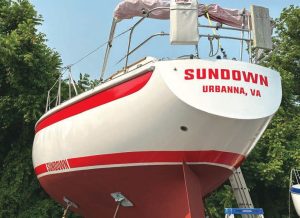
With the painting and graphics complete, Sundown is ready to go back into the water.
Or so I thought. When I asked the yard about stepping the mast, I was told that their usual crane operator, who had pulled the mast in November, was not available because the crane was down for repair. Many phone calls to local companies did not produce any affordable results, and it looked like Sundown would be mastless and stuck on the hard for the foreseeable future.
Fortunately, a marina friend who had pulled the mast of his Bavaria the previous year steered me to the local crane operator he had used. I was a little leery, as this was only a 50foot crane and I had a 5 7foot mast, but after discussing the logistics for attaching the crane just above the midpoint of the mast, I decided to give it a shot. I shouldn’t have been concerned. The operator manipulated the controls of that crane like Chopin played a piano, and other than having to clean up a pile of urethane fragments that spilled out of the mast through the cabin top and onto the step, things went more smoothly than I could have hoped for.
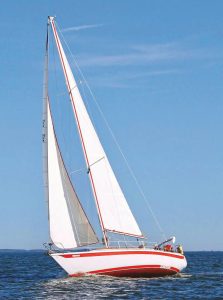
Sundown heads up the Potomac River with the bit in her teeth and the hull graphics on display.
Once the mast was up and the boat back in the slip, Keith came back to tune the rig. He completed that quickly, then it was time to run up the new genoa that Evolution Sails had made over the winter. It fit perfectly, and its sun band gleamed a bright red to match the new paint on the hul l and the mast.
We still have a lot to do, with the topside needing new paint in the near future and many other projects still on the list. But for now, we are happy that Sundown’s hull and mast have been restored and are shining brightly. We have been told already by many passing boaters that, “She looks like new!” I like to think Gordon Lightfoot would have been pleased to see his old boat rejuvenated, and the gleaming new paint on the hull makes me think of a line from his famous song: “She’s been looking like a queen in a sailor’s dream …”
In this sailor’s dream, she certainly does look like a queen.
Marc Carraway is a lifelong sailor, a former high school principal, and a longtime professional musician who has sailed all over the Chesapeake Bay and in the Mediterranean. He and his wife, Lisa, live in Urbanna, Virginia, and sail their Ericson 39B, Sundown, with their dog, Stella, in between gigs with his band, Scuffletown.
Thank you to Sailrite Enterprises, Inc., for providing free access to back issues of Good Old Boat through intellectual property rights. Sailrite.com

